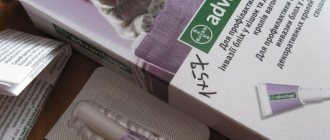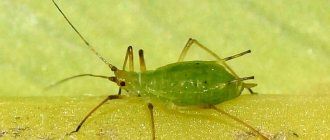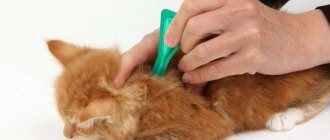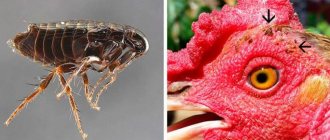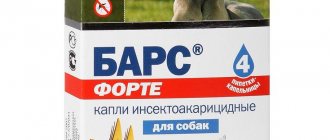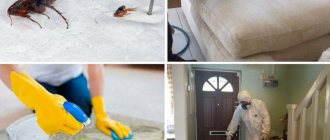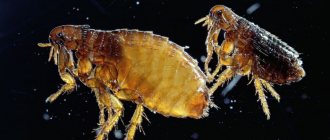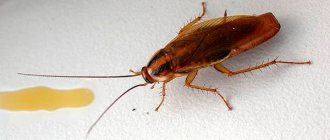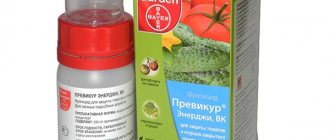Causes of flea infestation
It is impossible to completely and forever protect a dog from parasites, because there are incredibly many possibilities for infection with them. Whether on the street or in the apartment, there are no safe places. Fleas can be found anywhere, even in the most unexpected places. But we can identify the main reasons for the appearance of “vampires” in animals:
- Any walks in nature or even around the city;
- Contact with other animals;
- Larvae.
In the first case, it is obvious that hungry insects are patiently waiting for victims. They have no preference in choosing where to ambush. Grass, foliage, and soil will do. They can be found on the playground, on sidewalks and on public transport. They are everywhere. And there is a simple explanation for this: an animal overpopulated with fleas throws off some of the parasites.
But the risk of having uncomfortable “guests” is even higher - communication between pets. A dog easily picks up fleas, even if it is half a meter away from an infected animal. There is also a risk when interacting with a completely domestic animal.
Larvae, like fleas themselves, can be everywhere. But they are the easiest to bring into a person’s house. On shoes or clothes along with dirt and stuck leaves.
Fleas are tenacious creatures. It is not difficult for them to move freely from one place to another in search of food. They can get into the house through open windows and doors, and even in women's handbags or grocery bags.
IMPORTANT: Fleas are often confused with lice. They are easy to distinguish: the body of lice is usually large and flat, and the legs are short. Fleas are brown in color and lice are grayish-white. The latter are less common, mainly in unkempt pets and stray dogs.
Flea classification
It is difficult for a non-specialist to distinguish one type of flea from another, because to the eye they look the same. But the flea classifier includes many families and species of these insects.
Most often, it is generally accepted to separate fleas according to their choice of prey: human, cat, rat, etc. There is also Ctenocephalidis Canis - this is the so-called dog flea. In fact, not only this species, but also many other species parasitize the dog.
The human flea feeds on the blood of both humans and their domestic animals. They are saturated with blood in 20 minutes, and then digest it for another six hours.
IMPORTANT: Subcutaneous fleas are a myth. There are many parasites that live under the skin, but fleas are not one of them. Duck mites are also mistakenly mistaken for fleas.
- The cat flea also parasitizes other animals and humans.
- A dog flea is similar to a cat flea, but lives a little less (six months to one and a half years). These insects are sources of flatworms and plague.
- More dangerous than the previous ones is the rat flea. She is a carrier of rat and mouse tapeworm.
- The black flea, unlike, for example, the dog flea, reproduces very quickly: the time from being in the larval stage to becoming an adult is barely four days.
- There are grass fleas that are mistaken for other species of fleas. Unlike the others, the grass one has wings, albeit barely noticeable. It is active from mid-spring to mid-summer, but there are exceptions. If you don't get rid of it in time, it can bother you all year round.
IMPORTANT: Grass fleas often inhabit vegetable gardens and eat plants. But this does not mean that they are harmless to humans and animals.
Another special species is the bed flea. Already from the name it is clear where it lives.
Read Removing the fifth toe from a puppy and an adult dog: 3 stages
How fleas reproduce on dogs
The peculiarity of their reproduction is that in cold weather they prefer not to mate. The ideal temperature for this is 18-25 degrees. Mating itself takes several hours, so it does not happen on the dog’s body, but somewhere in a secluded corner.
The life cycle of these bloodsuckers includes four stages:
- Egg. The female lays them little by little: only 4-8 eggs at a time. Eggs rarely remain on the pet itself; they usually fall to the floor due to their non-stickiness.
- Larva. The dog flea hatches after 8-14 days and begins to feed on the excrement of adults. She needs excrement because it contains undigested blood. Their diet also includes other waste, including rotted grass.
- Doll. After two molts, the pupa weaves a cocoon, which subsequently sticks to it. The flea remains in this stage until a victim appears nearby.
- Imago. Adult stage. Their lifespan greatly depends on the conditions in which they live. At low temperatures they live longer.
Symptoms and external signs
The main symptom is the dog’s anxiety: it tends to change its position while resting, twitch, and jump up. A flea-covered dog stops loving bathing. Any entry into the water evokes an irresistible desire to get out onto land.
An obvious sign is that the animal has bitten itself, scratched itself furiously, and its eyes are filled with irritation or anger.
Other signs are visible when scratching: red spots on the skin (this is not an indicator if the dog has allergies), eggs and excrement on the fur. Wounds and areas with ulcers also indicate possible infection.
Fleas bite in their favorite places - the withers, ears and stomach. That's where you should look for them first.
Rating of the best drugs
Today there are a large number of drugs that can be used to treat young dogs. However, despite all the diversity, it is quite difficult to remove parasites, so you need to know exactly which remedy is best.
All drugs are divided into several groups:
- shampoos;
- drops;
- sprays;
- solutions (for example, hellebore water);
- collars.
The undisputed leader among shampoos is Beaphar.
The undisputed leader among shampoos is Beaphar. This is confirmed by numerous certificates, as well as the great popularity of the company’s products. Animal shampoo has four levels of action:
- Fight against parasites.
- Preventing re-infection.
- Cleaning areas where an infected puppy has been.
- Deworming.
Drops are no less effective. This product is applied only to the neck area - where the dog cannot reach with its tongue and paws. This is necessary to prevent the pet from licking the poison. Babies can be given drips from the age of one month. The animal should not get wet for 24 hours after the procedure, so you should not bathe it or walk with it in the rain. To get the best effect, the animal can be treated several times.
Shampoo is used once
It is important to avoid contact with the mucous membranes of the eyes, ears or tongue.
The third option is a special collar for your pet. It is used for the prevention of infection rather than for treatment. You can be sure that there are no fleas if you constantly follow preventive measures. The collar can be used at any age, which is especially suitable for small pets.
The choice of other options is large - drops, solutions, and shampoos. What is the best flea treatment for puppies? The question is controversial. It is advisable to use several options.
The danger of fleas for dogs and humans
In addition to discomfort, the dog has a risk of getting sick or becoming infected with something else. Fleas are especially dangerous due to the following consequences:
- Plague;
- Infestation by tapeworms and other parasites;
- Typhus;
- Ulcers, including anthrax;
- Allergy;
- Brucellosis;
- Listeriosis;
- Anemia;
- Fungal infections;
- Encephalitis;
- Salmonellosis.
Fleas will not spread to humans, but if they bite, they will bite. Accordingly, the owners have the same risks.
How to remove fleas from a dog
Getting rid of them should begin immediately from the moment the “vampires” are discovered. When a dog is literally eaten by fleas, much more serious and expensive treatment may be needed.
Shampoos
Most harmless and suitable for puppies. Especially those based on natural ingredients. Insecticidal shampoos easily cause allergies.
For thorough flea removal, it is better to use something else.
Popular shampoos: “Doctor Zoo”, “Bars”, “Clandestine”, “Beaphar”, “Master Bruno”, “Lugovoy”, “Fitoelita”.
You can make your own shampoo. They do it like this: rub baby soap, pour in three glasses of water or a decoction of herbs (it can be wormwood, geranium or lavender), cook over low heat until thick, cool, add three egg yolks to everything. If desired, add essential oil (any effective one). It must be used immediately: lather and leave for ten minutes, then rinse with vinegar, strongly diluted with water.
Read Nausea and vomiting in dogs: causes, signs and treatment
Sprays
Among the advantages is the ability to destroy insects over a large area at once. This option is inconvenient, as it imposes some restrictions:
- After use, you must not wash your dog for two days;
- Handling must be done with gloves;
- It is necessary to ensure that the dog does not lick the product;
- It is recommended to use outdoors or in a well-ventilated area.
Popular sprays: “Bars”, “Hartz”, “Beaphar”, “Frontline”.
Drops
Flea drops have gained popularity in the market due to their strong insecticide properties. They last for about a month, protecting your pet from re-infection. Apply on the back between the shoulder blades and sacrum. As with the spray, the dog is not washed for two days.
Popular drops: “Stronghold”, “Bars”, “Practik”, “Clandestine”, “Frontline”, “Advocate”, “Blokhnet”, “Advantix”.
If a dog has fleas, along with their destruction, it is imperative to disinfect the living quarters, the pet's kennel and those areas of the house that the animal visits. Suitable for this purpose are washing floors with wormwood infusion, cleaning carpets with baking soda and table salt (tromped into the carpet and left overnight).
Chewable tablets
Lozenges and tablets are not recommended for puppies under 14 weeks of age. They contain an insecticide that enters the bloodstream. This method of control is rarely resorted to - the death of the flea does not occur immediately and the owners have no desire to feed their pets poison.
Popular tablets: Sentinel, Capstar, Bravento, Comfort, Frontline.
Anti-flea collars
This remedy has a greater advantage in prevention than in the fight against an already large mass of parasites. Chemical collars are used for control. For the prevention of pregnant dogs - ultrasound and biological. The latter contain essential oils and plant extracts.
IMPORTANT: Insecticidal collars can cause harm to the animal. They have many contraindications that you should definitely familiarize yourself with.
The peculiarity of the collars is that they can be worn from two months to six months.
Popular collars: “Clandestine”, “Beaphar”, “Leopard”, “Doctor Zoo”, “Bolfo”.
Insectoacaricide powders
A budget option, but time-consuming. Like many products used to remove fleas, these powders are toxic. The method of applying the powder depends on the instructions.
Precautionary measures
When working with chemicals, follow the safety rules:
- Choose products for treating dogs wisely, taking into account the concentration of active ingredients, the age and condition of the pet.
- Use approved medications for puppies and pregnant dogs.
- Do not use products or collars that have expired.
- Follow the instructions in the instructions when handling animals. If your dog reacts poorly to the medication, stop taking it and contact your veterinarian.
- Do not overdose.
- When treating rooms with chemicals, remove small children and pets from the room.
- Use protective gloves and a mask, and goggles when working with aerosols.
- After treating the room, leave it for several hours. Usually the instructions indicate this time.
- Do not place insecticidal powders in areas accessible to children or small animals.
- Wash your hands and face, wash clothes after use.
Folk remedies for fleas
Sometimes toxic drugs are contraindicated for a dog, for example, during pregnancy. Then it is better to resist blood sucking at home, using folk remedies.
Herbs
The best assistant here is wormwood. It is rubbed into the pet’s fur in the form of a decoction, and the floors in the house are also washed with it. An alternative is tansy.
In rare cases, they resort to celandine, but with caution - it is toxic. It is infused with vodka and dripped onto the withers. Another option: use it to rinse your pet’s fur after a bath.
Another way to use herbs: pour tansy (1/4), eucalyptus (1/4) and wormwood (2/4) with boiling water overnight. And in the morning, walk around the house with a spray bottle.
Garlic
It is crushed and strained in boiling water, rubbed into the withers, and sometimes distributed over the back. It is added to food, but in small portions, as it is poisonous to pets.
Onion
It helps well when washing if rubbed and mixed with baby soap. Together with garlic, it can be applied to the withers in the form of a paste.
Laundry soap
When there are no necessary shampoos, they resort to soap, preferably tar. You need to make sure that it does not lead to dry skin. This soap is used to wash floors and everything the dog sleeps on.
Essential oils
They are added to shampoos, combined with tar soap and applied to animal bedding. These are mainly citrus fruits, geranium, mint, lavender, cloves, anise, fir, tea tree and eucalyptus. Should be used with caution: dogs do not like strong odors.
Needles
The animal's sleeping place is filled with sawdust. They can also serve as a replacement for bedding: just fill the mattress with them.
Read Adenoma of the eye (third eyelid) in dogs: causes, treatment and prevention
Vinegar
Suitable for small pets. The dog's entire body is sprayed with vinegar, then placed in a bag, except for the head, and kept there for about five minutes, then washed. It is necessary to ensure that the vinegar does not get into the eyes, nose and mouth of the animal and is rubbed into the roots of the fur.
For small breeds, salt is also suitable: a kilogram of salt is dissolved in a bucket of warm water, and the pet is dipped into this water for a few minutes. If desired, replace the salt with wormwood or another effective plant against fleas.
Other folk remedies include:
- Kerosene. They cannot treat the animal's body, but they can treat those places where fleas have been noticed. After rubbing kerosene into floors and other surfaces, leave it for a day, then ventilate thoroughly.
- Ammonia. They also treat the room. Ammonia is also supposed to be used to rinse the dog after bathing.
- Hellebore water. This tincture is used to treat the hair only if the dog does not have open wounds or scratches. Application to mucous membranes is not allowed.
- Hydrogen peroxide. Not suitable for show dogs, as the coat changes structure and becomes lighter. Peroxide diluted with water is applied to the wool and left for 25 minutes, then rinsed off.
- Camphor alcohol. Mix with table vinegar and a small dose of cologne. Apply before bathing, sometimes spray around the house.
- Boric acid. This relatively safe product destroys chitin, which is vital for fleas. A solution is made with this acid.
- Juniper fruits. Pour boiling water over two hundred grams and leave overnight. Used as drops against fleas.
Prices for medications for flea treatment of dogs
Russia
- Mr. Bruno, shampoo, 350 ml, from 260 to 280 rubles;
- Lugovoy, shampoo, 270 ml, from 140 to 155 rubles;
- Beaphar, shampoo, 250 ml, from 500 to 530 rubles;
- Bars(AVZ) Forte, drops, 4 pcs. 1.8 ml each, from 260 to 275 rubles;
- Frontline (Merial) Spot-On XL, drops, 4.02 ml, from 570 rub. up to 590 rub.;
- BlochNet max, drops, 1 pipette, from 130 to 145 rubles;
- Frontline (Merial), aerosol, 100 ml, from 950 to 1100 rubles;
- Beaphar Spot On Spray, spray, 400 ml, from 580 to 600 rubles;
- RolfClub, collar, from 255 to 270 rubles;
- Celandine, collar, from 90 to 100 rubles;
- Bravecto, chewable tablets, from 1250 to 1700 rubles;
- Eprimek, solution for injection, 100 ml, from 720 to 750 rubles.
Ukraine
- Phytoelite, shampoo, 220 ml, from 43 to 45 UAH;
- Frontline, spray, 250 ml, from 600 to 605 UAH;
- Bars, drops, 2 pipettes of 5 ml, from 114 to 115 UAH;
- Frontline, drops, 1 pipette, from 210 to 215 UAH;
- Bravecto, chewable tablets, from 680 to 685 UAH;
- Advocate, drops on the withers, 1 pipette, from 260 to 270 UAH;
- Bars, spray, 100 ml, from 107 to 110 UAH;
- Beaphar, collar, from 85 to 95 UAH;
- Mister Zoo, collar, from 15 to 20 UAH;
- Barrier, shampoo, 100 ml, from 20 to 22 UAH;
- Ivermectin-10, solution for injection, 50 ml, from 85 to 90 UAH.
Prevention
To ensure that fleas visit your dog much less often, you must follow these rules:
- Periodically disinfect the room, change and wash sleeping places;
- Vacuum carpets, cracks in the floor, burn disposable dust containers, and put an anti-flea collar in a reusable one;
- Keep contact with other animals to a minimum;
- Monitor your pet's behavior;
- Brush his coat regularly, preferably with a flea comb or a metal comb with firm, fine-toothed teeth;
- Walk in specially designated areas;
- Keep calamus leaves or branches of wormwood and tansy in the corners of the house, but only if the pet does not have allergies;
- Ventilate the house in winter - fleas cannot stand the cold;
- During the summer months, wear a flea collar before going for a walk;
- Be sure to examine the dog after mating or upon returning from a show.
If fleas are found on one of your pets, you will have to treat every single one of them, even if they show no signs. This is a necessary part of prevention.
Some owners begin to fight parasites only if they have already multiplied with might and main. They believe that fighting small insects is the same as going to drink tea. Indeed, sometimes this turns out to be simple, especially if the house is small and there is only one dog living in it. But we must remember that the struggle is not always easy, and the pet can literally experience agony.
Taking flea prevention is the responsibility of every dog owner.
Important conditions to resolve the problem
Important conditions for eliminating parasites include:
- Once fleas are discovered, action must be taken to eliminate them as soon as possible. If you hesitate, then after 1.5 weeks their number can increase up to 10 times.
- When choosing a product, it is recommended to consult a veterinarian, who will select the best option for the animal depending on its condition and age.
- It is very important to follow the instructions for the drug exactly - this will avoid poisoning and other health problems.
It is important to use an integrated approach to flea removal: you need to not only treat the pet itself, but also the room. It is recommended to combine industrial insecticides and traditional methods.
Reviews
All this is very tedious, you need to tinker. And even neutralize the house if the dog has fleas! At first I fought with all the means I could, but they still appear from somewhere. I had to spend money on ivermectin - it is injected intramuscularly. Everything has been fine with my Gadget for several months now!
Our dog doesn't like collars. Always trying to take them off, naughty. We also tried aerosols, but then the whole apartment stank. He is allergic to pine needles, but wormwood helped. Only we didn’t just wash the floors with it, but scattered the dried stuff in the corners. No further processing is needed. Sometimes we still drip, but that's just how it is
Treatment of puppies
Removing parasites from puppies requires special care and attention on the part of the owners, since all modern drugs for adult dogs are not suitable for fragile organisms. And not even all folk remedies for fleas on dogs can be used in this case.
You can remove fleas from puppies using the following methods:
- Using special shampoos for puppies of a certain age;
- The use of special collars for puppies;
- Preparation of herbal baths;
- Washing with tar soap.
Shampoos from pharmacies should be used with extreme caution, as they can cause allergic skin reactions. It is also not recommended to use strong-smelling home remedies, such as lemon juice or apple cider vinegar, as they can cause problems with the sense of smell in puppies.
